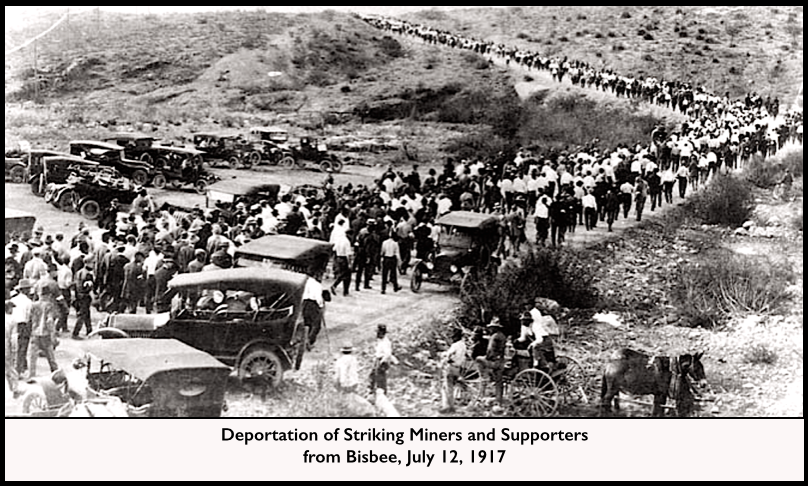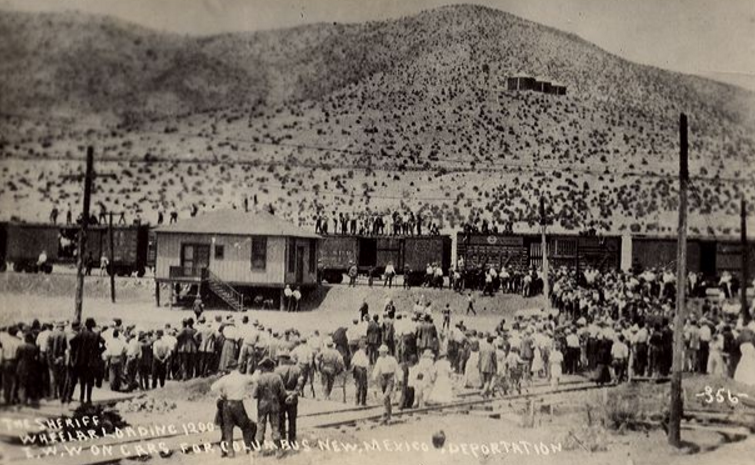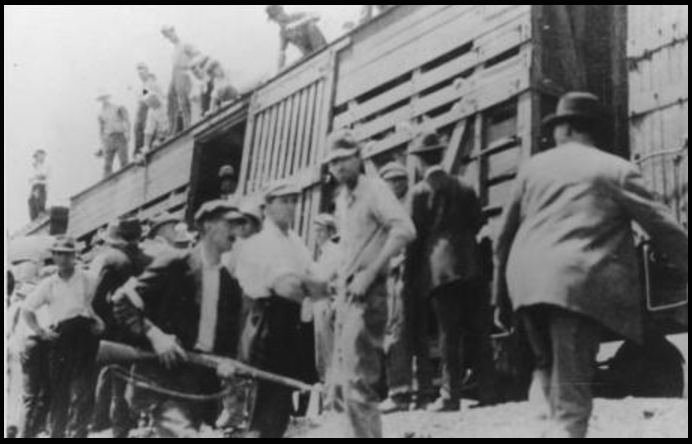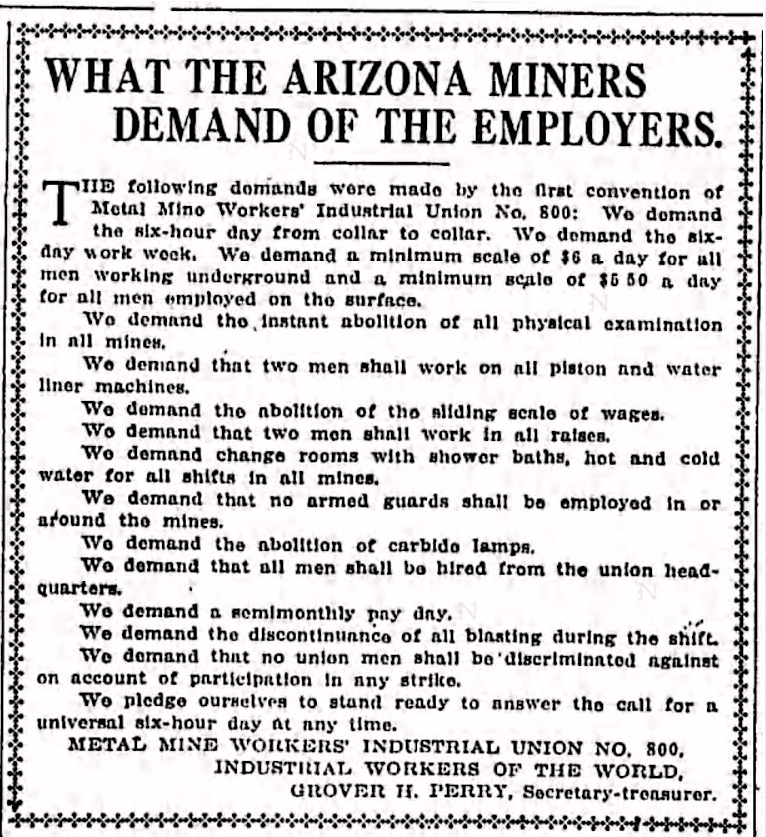powers of privilege will not go
to keep the workers in slavery.
-Mother Jones
Hellraisers Journal, Tuesday August 28, 1917
Bisbee, Arizona – Deputized Company Gunthugs Control City
From the Appeal to Reason of August 25, 1917:
The Truth About Bisbee
—–
—–
Bisbee, Ariz., has not formally seceded from the Union, but the mining companies of that district have set up an independent sovereignty-an industrial despotism-in utter defiance of American laws and the rights of American citizens. In the presence of this organized outlawry of capitalism, the great government of the United States remains passive and idle. Official Washington has virtually ignored the situation in Bisbee, just as it ignored the outrages in West Virginia and in Colorado and in a score of other places where capitalistic despotism sought to crush the workers. In connection with the Bisbee trouble it is interesting to note that one of the leading mining corporations of that district is the Phelps Dodge Company, and to recall that Cleveland H. Dodge, vice president of the Phelps Dodge Company, was a heavy contributor to the Democratic national campaign fund. A full and disinterested account of the happenings in Bisbee is given by the San Francisco Bulletin in a personal interview with Thomas McGuinness, a real estate dealer of Bisbee. The following is Mr. McGuinness’ story:
—–
The three great mining corporations of the Warren mining district, in which Bisbee is situated, are the Phelps Dodge Company, the C. & A. Company, and the Shattuck Company. The copper ore deposits there are among the richest and largest ever uncovered, and it is one of the most important copper districts in the world. Bisbee is a settlement of about 25,000 population. The three largest mining companies employed about 5000 miners.
The miners were American Federation men, I. W. W.’s and non-union men. While the companies exercised the utmost vigilance in excluding the I. W. W.’s many obtained employment by keeping their membership secret, and I am reliably informed that the company had no exact information as to what workers belonged to this organization.
Demands of Men.
When the strike was called June 24, about 80 percent of the 5000 men stopped work. Their demands were as follows:
A flat wage scale of $6 per day for underground workers. This meant an increase of 15 cents per day over the wage of $5.85, and the abolition of the shifting scale, by which the wage was determined according to the price of copper.
Two men to work in a raise.
No blasting while the men were on shift.
Two men to be employed on each machine drill.
The elimination of the physical examination.
The abolition of the contract and bonus system.
An agreement that there should be no discrimination against men on account of union affiliations.
Against Blacklist.
These demands are self explanatory with the exception of two. The men objected to physical examination because they believed it had been used in evasion of the Arizona law prohibiting black-listing. They contended that the company physicians carried out orders to find certain marked men physically unfit, and thus bar them from employment. The opposition to the bonus system was that it was designed primarily as a “speeding up” process, generally detrimental to the interest of the workers.
When, the day before the strike was called, the men presented their stipulations to Mr. Greenway, of the C. & A. Company and Mr. Shattuck, of the Shattuck Company, they were courteously received, and informed that their demands would be given consideration. Greenway told them that if they did not hear from him by five o’clock that afternoon, they would know that their demands had been rejected. Shattuck said any action he might take would require the endorsement of his board of directors and that he could not personally take any action.
Tore Up Demands.
Gerald Sherman, of the Copper Queen Company, a subsidiary company to the Phelps Dodge Company, which is the biggest company of the three, tore up the paper offered by the miners and threw it in the waste basket.
The next morning the strike was commenced. The miners began picketing on the supposedly public roads in the vicinity of the mines. The next day the sheriff posted notices that the roads were company property and the picketers withdrew to the streets of Bisbee. While I had no direct personal or property concern in the strike I was intensely interested and watched the developments closely. I can say without reservation that there was no violence. Speakers continually urged the miners to refrain from violence and the nearest approach to it appeared when a few pickets made occasional insulting remarks to men who had remained at work. For this they were disciplined by their fellow workers and after that all appeals for co-operation in the strike were respectfully made.
One-fourth at Work.
The Phelps Dodge Company closed one of its properties at Tombstone and brought a number of men from these mines to Bisbee. With the men who had remained at work, including men such as foremen, mechanics and electricians, they were able to assemble a working force of 25 per cent, which, according to my best information, is about the percentage now at work. The Shattuck mine was virtually swept clean, only three men appearing on the first day of the strike. It did not turn a wheel again until after the deportation.
Bisbee is in Cochise county, of which Tombstone is the county seat. Sheriff Harry C. Wheeler was summoned from Tombstone to preserve order. Employes of the various companies were sworn in as deputy sheriffs and armed. Wheeler posted notices and published them in the newspapers denouncing curtailment of copper production as treason, and appealing to all good citizens for assistance.
—–
Wanted No Violence.
Leaders among the miners continually urged them to refrain from violence, and all the strikers went without coats to show that they did not carry arms. This rule among them was so rigidly enforced that if a workingman were seen in the town with a coat on he was suspected of being a “gunman.” In 1,500 arrests made in the city, only three of the men were found with revolvers.
The mine owners employing the patriotic necessity of thwarting any interference with production formed a “kangaroo court.” A man named Merrill, a Mormon and a president of the “Workmen’s Loyalty League”, was appointed judge. Many bosses of the mines were sworn in as deputy sheriffs. These sheriffs arrested the strikers, one at a time, and on being brought before the kangaroo court they were given the alternative of going to work in the mines at once or getting out of town within from 12 to 24 hours. They examined each man closely as to whether or not he was an I. W. W. and if they found anything on him on which to base a suspicion of membership, the penalty was naturally more swift and summary.
Men Dispossessed.
The deputy sheriffs found an advantage in the system under which the miners had been allowed to live in Bisbee. The prevailing custom is for the miner to erect a shack on company land and pay a fixed monthly ground rent, according to the number of rooms. In extending this privilege, the companies made the leases revocable on twenty days’ notice, thereby making it easy to dispossess the “trouble makers” in an emergency such as this. While the miner is allowed twenty days’ in which to remove his shack or house from the company property, he may be removed without delay, so when the crisis came and the citizens wished to remove the disturbers, there were no cumbersome legal barriers to swift ejectment.
To remind the striking heads of families of the seriousness of interfering with the production of copper, and of the allegiance they owed to the mining company, a number of men were served with notices to remove their houses from the mining company’s ground within a period of twenty days; which meant the virtual confiscation of their homes.
The Copper Queen Mining Company had a band of paid musicians which had been employed to play at a public Fourth of July celebration. The band joined the strike and naturally the mine owners and city officials who were arranging the celebration, did not desire its participation and the band was so informed. When the strikers learned of this, they held a meeting in the city park and voted not to participate in the Fourth of July celebration, and asked all on strike not to appear on the street over which the procession passed on the Fourth of July for fear of trouble.
Mine officials, believing that drastic action was necessary, organized the “Loyalty League”. This organization claims to be patriotic in its purpose and aims eventually to rid the district of the troublesome foreign miners. Among the strikers there are Italians, Servians, Finns, Irish, English and Cornish workers and the league hopes to be increasingly effective in clearing Arizona of strikers.
Y. M. C. A. Loyal.
The Y. M. C. A. proved an effective ally for the forces of “law and order.” Arthur Notman, son of the treasurer of the Copper Queen Company, is head of the Y. M. C. A. directorate.
The only clergyman of Bisbee to take the part of the strikers was the Rev. Mr. Brewster, pastor of the Bisbee Episcopal Church. The clergyman is a man of culture and a student of the sociological problems. Before the start of the strike, he had become unpopular on account of the fact that he had publicly discussed child labor and employers’ liability legislation. Such discussion is regarded as unpleasant and dangerous in Bisbee.
Heading the Rev. Mr. Brewster’s board of vestrymen were Mr. Greenway, manager of the C. & A. mine and another man who was head accountant for the local water and light company. The clergymen’s interest in unsafe subjects was punished by the simple expedient of cutting off his salary. Although he remained in the settlement, continuing to insist that the miners had a right to demand better conditions, he was ostracised by the conservative element of the community and suffered poverty and insult.
The other clergymen of the city have stood solidly with the mine owners and the Y. M. C. A. has been used as the assembly place of the armed [company gunthug] deputies.
William Cleary, an attorney, who for several years has taken the side of the miners in the labor disputes, was deported with the strikers and is still held in the stockade at Columbus, N.M., with nearly 1200 other man. About ten years ago an ordinance was passed in Bisbee forbidding discussion in the streets. Three years ago Cleary announced that he would the test the validity of the ordinance by making an address in the street. He did so and by a public campaign rendered the ordinance inoperative. At the same time, he procured the co-operation of the miners in paying for a small public park where they have since held meetings.
The deportation of the 1194 miners, which has called the attention of the entire country to Bisbee, took place July 12. The men who had not previously been sent out of town were taken from their homes and herded together in the ball park. With the efficiency which has characterized every phase of the mine management in this district, the park was surrounded with mounted machine guns. This cordon of machine guns was a sight to discourage resistance and it is doubtful whether, even if the miners had been armed, they would have been recalcitrant. The men were kept in the park until 2 o’clock in the afternoon. The deputies allowed their wives and children to bring them sandwiches.
Off to Columbus.
—–
Bisbee believed, having been so informed by the mine owners through the newspapers that arrangements had been made to turn over the strikers to the military authorities at Columbus, N. M. At 2 o’clock in the afternoon the men were loaded on cattle cars and taken to Columbus, 160 miles across the desert, in custody of 200 armed deputies. When they reached Columbus, the officers in charge of the troops encamped there said they had received no orders regarding them and refused to receive them. The authorities of Columbus refused to allow them to remain and the train was backed 20 miles to Hermanas, a desert “tank” station.
Here the deputies became alarmed and slipped away under cover of darkness. The next day Attorney Cleary got in communication with the Federal authorities. The men were then taken back to Columbus and put in the stockade which had been built to hold Mexican prisoners after Villa’s raid on that town. They are still there, as obviously the mine owners of Bisbee will not allow them to return.
The exiled men later said that, when they were left at Hermanas, they were without food for 36 hours. I have no accurate information as to what food provisions were made, although I was informed that, when non-union bread from Los Angeles was given the men on the cattle train, they threw it into the sage brush, insisting they would rather starve than eat it.
A number of business men who had expressed sympathy with the miner were among those deported. These included Peter Vucavitch, a restaurant owner, who had purchased $500 worth of Liberty Bonds.
There has been much written regarding violence in the district before the deportation. There were two deaths. A striker named Brew who was a member of the Globe, Arizona, Lodge of Elks, was killed by deputies when he resisted their attempt to take him from his home and deport him. In the encounter he killed Deputy Sheriff O. P. McRae. The citizens of Bisbee are now subscribing to a fund for a monument for McRae.
Sewed Up Wounds.
I have no specific information regarding the attacks said to have been made by the deputies on the men on the cattle train, although I learned that, after the arrival in Columbus, army surgeons sewed up scalp wounds for five of the men.
Mine officials and their deputies continued their deportations of individuals, before and after the wholesale deportation. An insurance solicitor named Griffin, representing the Occidental Insurance Company, had made a phenomenal success of his business. He was a newcomer and unpopular in the established business. Six men visited him at night, told him they had learned that his wife was a German spy and gave him until sunrise to leave town. He left.
The refusal of the Bisbee deputies to admit an investigating committee of the A. F. of L. to enter the city was reported after my departure, as was their alleged refusal to allow the attorney general to conduct an investigation. I know nothing of these incidents personally.
Gun Men in Khaki.
Before I left Bisbee the companies had extended and strengthened their military organization and secret service, and entrance to Bisbee is now dependent upon the sanction of the allied interests of the mining region. Railroad access to the town lies through Osborne, a junction point, nine miles from Bisbee, where a branch line connects with the main line. The companies have stationed a dozen men here to examine any man who appears to be a workingman. The deputies wear khaki uniforms, the men submit readily, supposing their inquisitors to be soldiers and the method is proving extremely effective.
Automobile entry to Bisbee from the east is via Douglas, about 30 miles away. Mine owners and business men in this vicinity are cooperating closely with the Bisbee mine owners and have evolved a plan designed to bar “undesirables.” Any person desiring to go to Bisbee via Douglas must obtain a passport from the Douglas Chamber of Commerce. Persons seeking this official endorsement are given a searching examination, and there is no possibility of any person expressing sympathy with the strikers entering the Warren district.
Charity for Families.
It will be recalled that 433 of the departed men were married. Many of them have wives and children. These families are now being cared for by public charity. Mine officials deny that the women and children have suffered and point to the fact that the charity contributions will be quite sufficient to take care of them until they are sent somewhere.
Summarized, my observations were as follows:
Not only did the miners refrain from violence, but they rigidly policed their own organizations to prevent violence.
Three miners out of 1500 carried guns.
Men with families who had been in the district 15 years, purchasers of Liberty Bonds, contributors to the Red Cross, citizens, property owners and business men, were herded in cattle cars, under a blazing sun and deported 140 miles across the desert and abandoned without food and shelter.
No evidence was offered to show that the strike was caused by I. W. W. agitators, that it was financed by German money, or that it grew out of anything save the demands stated above.
Wives and children were left to be cared for by charity.
The entry of any citizen to Bisbee, on any mission, is now dependent on the permission of the mine owners of the Douglas Chamber of Commerce.
I have no personal concern in the Bisbee affair, with the exception of the fact that some of my clients were deported. My natural affiliation is of course, with the business element of the community which was allied with the mine owners. But on being asked to give my impressions as accurately as possible, I related the facts to the best of my knowledge. The foregoing is a true statement of what happened in Bisbee.
———-
[Photographs and emphasis added.]
From The Los Angeles Times of July 4, 1917:
SOURCE
Appeal to Reason
(Girard, Kansas)
-Aug 25, 1917
https://www.newspapers.com/image/67312803/
IMAGES
Bisbee Deportation Miners and Supporters July 12, 1917
http://www.library.arizona.edu/exhibits/bisbee/primarysources/photographs/deportation.html
Bisbee Deportation, White Arm Band Gunthug, libcom
https://libcom.org/gallery/images-1917-bisbee-deportation
Bisbee Deportation, IWW in cattle cars to desert, July 12, 1917
https://en.wikipedia.org/wiki/Bisbee_Deportation
IWW, MMWIU 800, AZ Demands, LA Tx, July 4, 1917
https://www.newspapers.com/image/156016808/
See also:
Tag: Bisbee Deportation of 1917
https://weneverforget.org/tag/bisbee-deportation-of-1917/
Note: Rev Harold S. Brewster of St John’s Episcopal Church
of Bisbee is mentioned several times in Bisbee Daily Review
from Nov 1915-Sept 1917
https://www.newspapers.com/search/#query=%22rev+harold+s+brewster%22+bisbee
Also note: “Rev Harold S Brewster” going to Bisbee to assume rectorship of St. John’s in 1907
https://books.google.com/books?id=OLwmAQAAIAAJ
Solidarity Forever
-performed by present-day IWW member, FW Tom Morello
-lyrics by Ralph Chaplin, 1915




